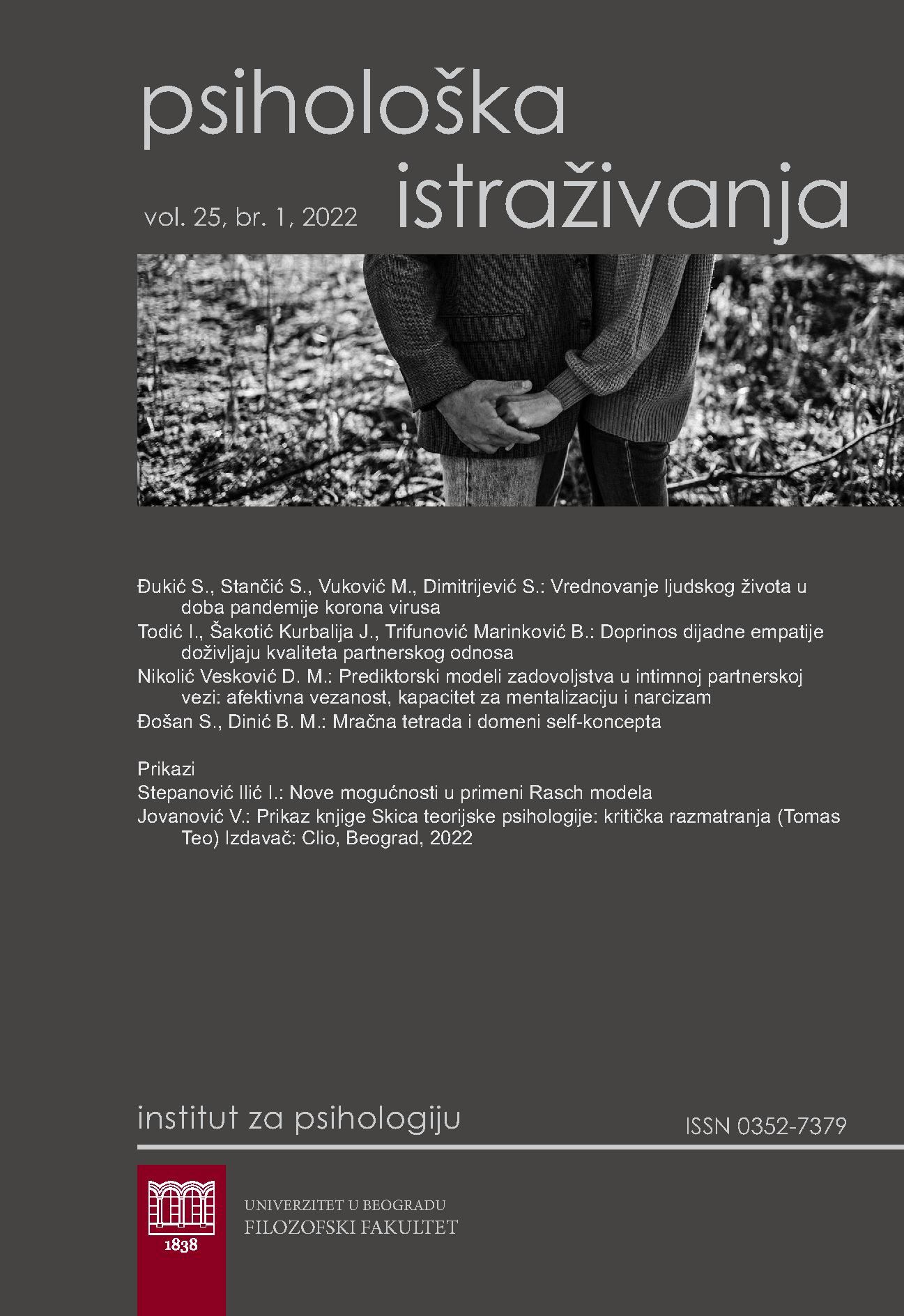Evaluation of human life at the time of the pandemic coronavirus
Abstract
The aim of this study was to determine whether people are subject to psychophysical numbness during the coronary virus pandemic and whether they estimate human lives to be less valuable as the numbers of those infected and who die from this virus increase. In two experiments, the contextual influence of the ratio of the number of cured-infected and positive-negative framework on the evaluation of the contribution of medical workers, as a measure of the value of human lives, respectively, was examined. In the third experiment, it was examined whether the type of inevitable disaster and the amount of money for repairing the consequences affect the evaluation of life. The contribution of medical workers in the first experiment was estimated by 354, 725, 729 respondents, respectively. The results suggest the assessment of the contribution of health workers does not depend on the number and percentage of curing, and the main effects of the scenario (pandemic curve) and framework (positive/negative) are not significant, while their interaction is statistically significant. The results of the third experiment suggest that the evaluation of human lives does not depend on the type of catastrophe (pandemic vs. flood) but that it depends on the amount of funds allocated for rescuing endangered people. These results have implications for decision-makers during disasters, who should avoid giving only numbers when reporting, but combine information on the number of survivors and deaths depending on the current situation, as well as report on individual cases, regardless of the type of disaster.
References
1KA (Version 17.05.02) [software]. (2017). Ljubljana: Faculty of Social Sciences. Available via https://www.1ka.si
Cameron, C. D., & Payne, B. K. (2011). Escaping affect: How motivated emotion regulation creates insensitivity to mass suffering. Journal of Personality and Social Psychology, 100(1), 1–15. https://doi.org/10.1037/a0021643
Doheny, K. (2020, December 23). As COVID Numbers Rise, So Does “Psychic Numbing. ”WebMD“. https://www.webmd.com/lung/news/20201223/as-covid-numbers-rise-so-does-psychic-numbing
Fetherstonhaugh, D., Slovic, P., Johnson, S., & Friedrich, J. (1997). Insensitivity to the Value of Human Life: A Study of Psychophysical Numbing. Journal of Risk and Uncertainty, 14(3), 283-300. Retrieved January 9, 2021, from http://www.jstor.org/stable/41760856.
Friedrich, J., Barnes, P., Chapin, K., Dawson, I., Garst, W., & Kerr, D. (1999). Psychophysical Numbing: When Lives Are Valued Less as the Lives at Risk Increase. Journal of consumer Psyshology, 8(3), 277-299
Hameleers, M. (2021). Prospect Theory in Times of a Pandemic: The Effects of Gain versus Loss Framing on Risky Choices and Emotional Responses during the 2020 Coronavirus Outbreak–Evidence from the US and the Netherlands. Mass Communication and Society, 00(00), 1–22. https://doi.org/10.1080/15205436.2020.1870144
Kahneman, D., & Tversky, A. (1979). Prospect theory: An analysis of decision under risk. Econometrica, 47, 263–291
Otterbring, T., Festila, A., & Folwarczny, M. (2021). Replication and extension of framing effects to compliance with health behaviors during pandemics. Safety Science, 134(October 2020), 105065. https://doi.org/10.1016/j.ssci.2020.105065
Rachev, N. R., Han, H., Lacko, D., Gelpi, R., Yamada, Y., & Lieberoth, A. (2020). Replicating the “Asian Disease” Framing Paradigm During the 2020 COVID-19 Pandemic: A Study of Stress, Worry, Trust, and Choice Under Risk. May. https://psyarxiv.com/rbfwp/
Slovic, P. (2014). Što ih više umire, to se manje brinemo. Uvod u bihejvioralnu ekonomiju – Institut društvenih znanosti Ivo Pilar, 115-122. Zagreb, 2014. ISBN 978-953-7964-09-2.
Slovic, P. (2007). “If I look at the mass I will never act”: Psychic numbing and genocide”. Judgment and Decision Making, 2(2), 79–95
Universal Declaration of Human Rights. (n.d.). Retrieved from https://www.un.org/en/about-us/universal-declaration-of-human-rights
World Health Organization. (2021, October 12). Weekly epidemiological update. Retrieved from: https://www.who.int/publications/m/item/weekly-operational-update-on-covid-19---12-october-2021
Authors retain the copyright of the published papers and grant to the publisher the nonexclusive right to publish the article, to be cited as its original publisher in case of re-use, and to distribute it in all forms and media. The published articles will be distributed under the Creative Commons Attribution ShareAlike 4.0 International license (CC BY-SA). It is allowed to copy and redistribute the material in any medium or format, and remix, transform and build upon it for any purpose, even commercially, as long as appropriate credit is given to the original
author(s), a link to the license is provided, it is indicated if changes were made and the new work is distributed under the same license as the original. Authors are permitted to deposit the author’s publisher’s version (PDF) of their work in an institutional repository, subject-based repository, author’s personal website (including social networking sites, such as ResearchGate, Academia.edu, etc.), and/or departmental website at any time after publication, with an acknowledgment of its initial publication in this journal.

